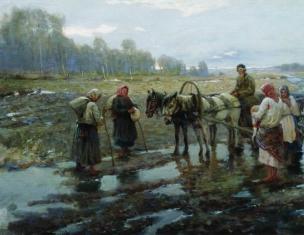Theme of the story: the fantastic and the real in depicting St. Petersburg reality with the help of satire.
The idea of the story: to force people to feel the vulgarity that surrounds them, since vulgarity has only one thought about itself, because it is unreasonable and limited and will not see or understand anything around except itself.
Characteristics of the main characters:
Kovalev is a collegiate assessor, “a man neither evil nor good,” all his thoughts are fixated on his own personality. This personality is invisible and he tries to embellish it. Talks about his acquaintances with influential people. Very preoccupied with worries about his appearance. How to stir up this person? Just put it in a marital status.
Ivan Yakovlevich, a barber, like every Russian artisan, “was a terrible drunkard,” unkempt.
Our experts can check your essay according to the Unified State Exam criteria
Experts from the site Kritika24.ru
Teachers of leading schools and current experts of the Ministry of Education of the Russian Federation.
The discovery of Kovalev's nose, which he shaved twice a week, left him numb with horror. He was neither alive nor dead. I had a hard time getting rid of my nose.
Impression of the book: at first it seems that this story is a joke. But there is some truth in every joke. Gossip, pettiness, arrogance - all this is vulgarity. Vulgarity has no kindness, nothing noble. Fantastic details enhance the satirical portrayal of St. Petersburg society and individual representatives, such as Major Kovalev.
Gogol’s story “The Nose” caused a lot of discussion and angry criticism towards the author. The summary tells of a fantastic story that under no circumstances could have happened for real. Due to the unrealistic nature of the plot, not all magazines agreed to publish this work; the writer even had to make changes to his story several times. Few of Gogol’s contemporaries understood that “The Nose” has a double meaning. Describing the absurd situation, Nikolai Vasilyevich wanted to show the flaws in the society of his time.
Missing nose
An amazing incident occurred on March 25, it was then in the morning that the barber Ivan Yakovlevich found the nose of his client, the collegiate assessor Kovalev, in the bread baked by his wife. The man decides to get rid of such a find, but constantly drops it, as others point out to him. In the end, the barber throws his nose into the Neva. Meanwhile, Kovalev wakes up and goes to the mirror to look at the one who has jumped up, but does not even find his nose.
The fact that the collegiate assessor is in dire need of decent appearance is told (this is, in fact, stated in the work itself) summary. The nose destroys all his hopes, because Kovalev came to the capital in order to find himself good job and get married. The loss of such a significant part of the body makes the assessor powerless and useless to anyone.
Meeting with the nose

The summary of Gogol’s story “The Nose” tells that, somehow covering his face, Kovalev goes to the chief of police, but on the way he meets his lost part of the body. Nose, dressed in a hat with a plume, a uniform embroidered with gold, with the rank of state councilor, gets into a carriage and goes to the Kazan Cathedral to pray. The major goes after him, at first Kovalev even becomes shy at the sight of such a noble official. When asked to go back, the nose pretends that it does not understand what it is about and the collegiate assessor does not succeed in his intentions.
Chief Police Chief Kovalev is not at home, so he goes to advertise in the newspaper about the missing part of the body, but even there he fails - this is what the summary of the work tells about. A decent person’s nose cannot just disappear, so the private bailiff only listens to the major’s complaint with irritation and does nothing to help.

Upset, Kovalev comes home and begins to think about the reason for his misfortune. And then it occurs to him that perhaps staff officer Podtochina is to blame for everything, having hired some witches, because the collegiate assessor was in no hurry to marry her daughter. When the policeman brings a nose wrapped in paper, Kovalev is overcome with joy - this is what the summary conveys to us. The nose, meanwhile, doesn’t even think about sticking to its place.
Happy ending
Rumors spread throughout the capital that the nose of the collegiate assessor was strolling along Nevsky Prospekt, walking in Junker's store. But on April 7, everything fell into place - Kovalev woke up and discovered the loss in its rightful place.
The summary of “The Nose,” although brief, still contains the story that in just one day the major managed to visit many places: a pastry shop, a department, and was even lucky enough to meet Podtochina and his daughter. And the author interrupts the description of the happy Kovalev in the story with the admission that this story is made up. Gogol is even surprised that some writers take such stories as the basis for their works.
One of the characteristic features of N.V. Gogol’s skill is the ability to make a masterpiece from a randomly heard story or a popular anecdote. A striking example of such a writer’s ability is the story “The Nose,” which caused a lot of controversy among contemporaries and has not lost its relevance to this day.
The work “Nose” was written by N.V. Gogol in 1832-1833, it is included in the collection “Petersburg Tales”. The plot of the book is based on a well-known joke at that time, translated from French, about a missing nose. Such stories were very popular and had many variations. For the first time, the motif of the nose, which prevents one from living fully, appears in Gogol’s unfinished essay “The Lantern Was Dying” in 1832.
This story has undergone many changes over the course of several years, which was due to censorship comments, as well as the author’s desire to best realize his idea. For example, Gogol changed the ending of “The Nose”; in one version, all incredible events are explained by the hero’s dream.
Initially, the writer wanted to publish his work in the Moscow Observer magazine, but he was refused. A.S., who had already opened his own magazine by that time, came to the rescue. Pushkin, and the story “The Nose” was published in Sovremennik in 1836.
Genre and direction
By the time the story “The Nose” was published, Gogol had already become famous for his collection “Evenings on a Farm near Dikanka,” where he addresses the theme of mysticism. But if “Evenings...” are mostly based on folk superstitions, then in “ Petersburg stories"Nikolai Vasilyevich skillfully interweaves supernatural motifs with the depiction of poignant social problems. This is how a new direction for Russian literature is formed in Gogol’s work - fantastic realism.
Why does the author come to this particular writing method? Throughout his entire literary career, he heard social dissonances, but, as a writer, he could only identify them in his works and encourage the reader to pay attention to them. He saw no way out, and turning to the fantastic made it possible to depict the picture of modernity even more dramatically. This same technique would later be used by Saltykov-Shchedrin, Andrei Bely, M. Bulgakov and other authors.
Composition of the story
Gogol divides “The Nose” into 3 parts, in a classic way: 1 – exposition and plot, 2 – climax, 3 – denouement, a happy ending for the main character. The plot develops linearly, sequentially, although the logic of certain events is not always explained.
- The first part includes characteristics of the characters, a description of their life, as well as the starting point of the entire narrative. In its structure, it also consists of three blocks: detection of the nose - the intention to get rid of it - release from the burden, which turned out to be false.
- The second part introduces the reader to Major Kovalev himself. There is also a plot (discovery of the loss), development of the action (an attempt to return the nose) and, as a result, the return of the nose.
- The third movement is homogeneous, a laconic and bright chord that completes the work.
About what?
The description of the story “The Nose” can be reduced to a fairly simple and schematic plot: loss of the nose - search - acquisition. The main thing in this work is its ideological content.
On the morning of March 25, barber Ivan Yakovlevich discovers the nose of one of his clients, Major Kovalev, in his bread. The discouraged barber hastened to get rid of the evidence; he could not think of anything better than accidentally throwing his nose into the river. Ivan Yakovlevich already felt relieved, but a policeman approached him, “and absolutely nothing is known what happened next.”
Collegiate assessor Kovalev woke up and found his nose missing. He goes to the “Chief Police Chief”. He didn’t find him at home, but on the way he met his nose, which behaved self-sufficiently and did not want to know its owner. Kovalev is making attempts to reunite with his nose, he wanted to publish an ad in the newspaper, but he is refused everywhere and treated quite rudely. Finally, the fugitive was caught trying to emigrate and returned to his owner. But the nose was not going to grow back to its original place. The major comes to the assumption that this is damage caused by headquarters officer Podtochina. He even writes her a letter, but receives a puzzled response and realizes that he was mistaken. Two weeks later, Kovalev finds his face in its original form, everything resolves itself.
Real and fantastic
Gogol skillfully combines in his story. If, for example, in “The Overcoat” the mystical element appears only at the end of the work, then “The Nose” from the first pages carries the reader into the writer’s fairy-tale world.
At its core, there is nothing special in the reality depicted by Gogol: Petersburg, the life of a barber and a state councilor. Even topographical details and exact dates of events correspond to reality. The author dilutes such plausibility with one single fantastic element: Major Kovalev’s nose runs away. And throughout the work, he develops from the separated part to an independent independent personality, and in the finale everything returns to normal. It is curious that this fact, although it shocks the reader, is woven into the fabric of the work quite organically, because the greatest absurdity lies not so much in the escaped part of the face, but in the attitude towards what happened, in admiration for officials and aspirations for public opinion. According to the writer, such cowardice is more difficult to believe than the disappearance of the nose.
The main characters and their characteristics
- Petersburg There is much more to Gogol’s “The Nose” than just the city. This is a separate place with its own laws and realities. People come here to make a career for themselves, and those who have already achieved some success try not to fade in the eyes of others. Here everything is possible, even the nose can become independent for a while.
- Traditional for Gogol image of a little man represents the character Major Kovalev. What matters to him is how he looks; the loss of his nose drives him into despair. He believes that you can do without an arm or a leg, but without a nose - you are not a person, “just take it and throw it out the window.” The hero no longer occupies the lowest rank: 8 out of 14 according to the “Table of Ranks,” but dreams of a higher rank. However, even being at this level, he already knows with whom he can be arrogant and with whom he can be modest. Kovalev is rude to the cab driver, does not stand on ceremony with the barber, but ingratiates himself with respected officials and tries not to miss parties. But he is absolutely discouraged by the meeting with Nose, who is 3 ranks higher than his owner. How to deal with the part of yourself that doesn’t know its place in physical sense, but perfectly understands his position in society?
- Image of the Nose in the story is quite bright. He is superior to his master: his uniform is more expensive, his rank is greater. An important difference between them is their behavior in church: if Nos humbly prays, then Kovalev stares at beautiful woman, thinks about anything, but not about his soul.
Themes of the story
- The subject of the story is quite broad. Main topic, of course, social inequality. Each hero has his place in social system. Their behavior and role in society fully corresponds to their position, but this idyll cannot be violated. It will be strange if the highest official does not be rude to the titular councilor, and the titular councilor is not rude to the groom.
- The theme of the little man in the story is illuminated quite clearly. Major Kovalev, having no special connections, cannot publish an advertisement in the newspaper about his missing nose. The victim of the “Table of Ranks” cannot even come close to his property, which turned out to be more noble.
- The theme of spirituality is also present in the work. Kovalev does not have good education, military service allowed him to become a major, the main thing for him was appearance, not inner world. The nose is contrasted with the hero: the fugitive is focused on worship, he is not distracted by the surrounding ladies, unlike the owner. The major is characterized by frivolous behavior: he invites girls to his place and deliberately torments Podtochina’s daughter with imaginary hope.
Problems
- Gogol in “The Nose” reveals vices that concern both society as a whole and individuals. Main problem the story is philistinism. Kovalev is proud of his rank and dreams of a brilliant career. He is worried that his facial defect will interfere with his future plans. He values public opinion, and what kind of rumor can there be about a person without a nose?
- The problem of immorality is raised in the story. The barber does not seek to return the nose to the owner, or to admit his, perhaps, guilt in ruining the face. No, he is in a hurry to get rid of the strange object, hoping to remain unpunished. And the immorality of Kovalev’s behavior speaks for itself.
- Another vice highlighted by Gogol is hypocrisy. The arrogant Nose does not want to communicate with those of lower rank, just like his cowardly owner.
The meaning of the work
The main idea of the story is to show, through the contrast of paradoxes, all the depravity and cowardice of St. Petersburg society. One can consider the loss of the nose as a kind of punishment for Major Kovalev for his sins, but Gogol does not focus on this; the story is devoid of direct moralizing. The author did not dare to show the way to cure society; he could only identify the problems. This will give rise to the erroneous idea of a “natural school”: fix society and the problems will stop. Gogol understood: the most he could do to improve the situation was to present the shortcomings of society in the brightest light. And he succeeded: the reader was blinded, many contemporaries recognized their acquaintances or even themselves, horrified by the insignificance of man.
What does it teach?
In his story “The Nose,” Gogol depicts the spiritual crisis of a person obsessed with vain desires. Career growth, entertainment, women - that’s all that attracts the main character. And this depravity does not bother Kovalev, he has the right, along with all these aspirations, to be called a man, but without a nose, no. But the image of Major Kovalev is collective, he is similar to the writer’s contemporaries. The conclusion suggests itself: the situation in society dictates rules of behavior that no one dares to break: neither little man will not show persistence, nor will the high-ranking official show generosity. About the approach of such a catastrophe that will affect society as a whole and each person individually, N.V. Gogol warns his readers.
Artistic originality
The story “The Nose” uses a very rich literary toolkit. Gogol most widely uses such a means of expression as the grotesque. Firstly, this is the autonomy of the Nose, which is superior in position to its owner. Secondly, comic exaggeration is typical for depicting relationships between people of different social levels. Kovalev is afraid to approach Nos, and Ivan Yakovlevich begins to treat his client with incredible trepidation and excitement after the incident.
Gogol humanizes the nose, but the technique of personification is also used on an enlarged scale. The nose becomes independent from the owner, an almost full-fledged member of society, he even planned to flee abroad.
At the syntactic level, Gogol refers to zeugma: “Dr.<…>had beautiful resinous sideburns, a fresh, healthy doctor.” These features help the writer portray humor and irony in the work.
Criticism
The story “The Nose” caused a wide resonance in the literary environment of the first half of the 19th century. Not all magazines agreed to publish the work, accusing N.V. in the vulgarity and absurdity of what was written. Chernyshevsky, for example, treated this story as nothing more than a retold joke that existed at that time. The first to recognize the merits of “The Nose” was A.S. Pushkin, seeing the farcical nature of the creation. The review by V.G. was significant. Belinsky, who called on the reading public to pay attention to the fact that such Major Kovalevs in society can be found not just one person, but hundreds, even thousands. S. G. Bocharov saw the greatness of the work in the fact that the author here encouraged society to look into the eyes of reality. V. Nabokov considered this story one of the brightest images of the motif, which runs through the entire work of N.V. as a cross-cutting theme. Gogol.
Interesting? Save it on your wall!1. Features of N. V. Gogol’s story “The Nose”- realism and fantasy
2. Satirical Features of N. V. Gogol’s story “The Nose” .
3. The meaning of the image of the Nose-official.
N.V. Gogol is considered to be one of the founders of Russian realism. However, realism in the works of this writer is very often intertwined with fantastic images, complete deep meaning. Let us remember his “Evenings on a Farm near Dikanka”, the story “Viy”, the eerie images of which are associated with ancient pagan mythology, “Portrait” and even the well-known “Overcoat”, where the ghost of an official appears, tearing off his overcoat. The story "The Nose" is also a bizarre mixture real life Russia XIX century and a fabulous phantasmagoria, somewhat reminiscent of Odoevsky’s stories.
However, behind the fantastic story of the missing nose lies a merciless satire that ridicules human vices. Showing the family life of the barber Ivan Yakovlevich, Gogol demonstrates his lack of will and fear of his wife, his untidiness, not forgetting to mention his drunkenness, and as a completely natural phenomenon: “Ivan Yakovlevich, like any decent Russian artisan, was a terrible drunkard.”
We find typical views on marriage as a profitable deal and a way to get rich in the following lines: “Major Kovalev was not averse to getting married; but only in such a case when the bride gets two hundred thousand in capital.” Gogol ridicules his hero's self-interest, his fear of gossip, his ignorance and empty vanity - traits that are very common among bureaucrats. In the Newspaper Expedition, where Major Kovalev came to announce his disappearance, he behaves as if he was most afraid that his acquaintances would become aware of his misfortune and they would laugh at him: “No, why a surname? I can't say it. I have many acquaintances: Chekhtareva, state councilor, Palageya Grigorievna Podtochina, staff officer... Suddenly she finds out, God forbid! You can simply write: collegiate assessor, or, even better, holding the rank of major.” But in his situation, it is much more important to quickly find the nose, and not ask such questions - who will say what!
Comical Features of N. V. Gogol’s story “The Nose”- this is the hero’s reasoning about the reasons for the disappearance of the nose: “Major Kovalev, having considered all the circumstances, assumed, perhaps closest to the truth, that the culprit for this should be none other than the staff officer Podtochina, who wanted him to marry her daughter ... The staff officer, probably out of revenge, decided to spoil him and hired some witches for this purpose...” It should be noted that such an assumption is not even particularly logical. After all, even if Podtochina decided to resort to the help of “witch women,” she would rather prefer that they bewitch him to her daughter, rather than deprive the potential groom of his nose.
Features of N. V. Gogol’s story “The Nose”- this is a thoughtless veneration of rank that dominates the minds of people. He shows different sides this moral ulcer, when behind the uniform you sometimes cannot tell who is in front of you - a nose or a person.
Ivan Yakovlevich's fear of the police is one of the illustrations of the omnipotence of the bureaucracy in Russia. To the common man It was always difficult to prove something to officials, regardless of whether he was right or wrong. Therefore, “the thought that the police would find his nose and accuse him” completely upset the hapless barber.
We find the same reverence for rank in Kovalev’s desire to be called a major: “He had only held this rank for two years and therefore could not forget it for a minute; and in order to give himself more nobility and weight, he never called himself a collegiate assessor, but always a major.”
But the motif of veneration in Russia reaches its highest pitch in the scene of Kovalev’s conversation with his own nose. The grotesqueness and outward fantasticality of this episode only emphasize its true meaning. Kovalev has no doubt that in front of him is his own nose; and yet he is shy in front of him, because the chip on his nose is higher than his: “How to approach him? - thought Kovalev. - From everything, from his uniform, from his hat, it is clear that he is a state councilor. The devil knows how to do this?
IN fantasy story about an unprecedented incident - the escape of the nose - Gogol masterfully reveals the idea of the moral myopia of most people, accustomed to seeing only the rank, but not the one who wears it. Through the mouth of the policeman who brought Kovalev his nose, the author says the following words that express main idea story: “...the strange thing is that at first I myself mistook him for a gentleman. But fortunately, I had glasses with me, and I immediately saw that it was a nose. After all, I’m short-sighted, and if you stand in front of me, then I only see that you have a face, but I won’t notice a nose, a beard, or anything. My mother-in-law, that is, my wife’s mother, also doesn’t see anything.”
Fortunately for the hero of the story, the policeman put on glasses. But not only he needs glasses - glasses of impartiality that allow him to see a person, and not his rank.
Year of writing: 1835 Genre: story
Heroes: Platon Kuzmich Kovalev - collegiate assessor, Ivan Yakovlevich - barber, drunkard, Nose - escaped from the owner
Plot: The story introduces us to the extraordinary episode that happened to Kovalev. One day while having breakfast, the hairdresser finds a nose in a loaf of bread that belonged to the major. He tries in every possible way to free himself from this unnecessary object, but for a long time he does not succeed. Finally he throws his nose into the river. And Kovalev, having discovered that his nose is missing, suffers greatly. And when he returns to the owner, we see how the collegiate assessor calms down, and life seems so sad to him.
The author tries to expose all the vices of the St. Petersburg environment, showing the example of the main character Kovalev. After all, at first he appears before the readers arrogant person with his habits, but this loss exposes us to the major with all his negative qualities. Making people feel the vulgarity surrounding them is the main goal of the writer.
One day, a certain Ivan Yakovlevich found a nose belonging to Major Kovalev in bread. The barber wants to throw it away unusual thing, but those around him do not allow him to do this. Finally, he throws him into the water from the bridge, but the police chief reprimands him. In parallel with the events taking place, we see how the collegiate assessor, waking up, does not see the nose on his face. He gets hysterical. How so? How will he live next? Now he won’t be able to appear in decent families, and he won’t be able to hit on women either. And some beauties of St. Petersburg already know him well. But he was used to walking around the city in a neat uniform and always being a well-groomed man. What will they think when they see the gentleman in such an indecent form?
Covering himself with a handkerchief, Kovalev leaves the house and goes straight to the chief of police. On the way, he enters a drinking establishment and wants to look in the mirror. What if he imagined everything that happened? But instead of such an important organ there is only emptiness. Following further, he notices that his own nose, all dressed up, is coming out of the entrance of the neighboring house and is heading importantly towards the carriage. The major quickly rushes after him. And unexpectedly for him, the nose arrives at the temple for service. Kovalev, at first timidly and timidly tried to talk to him about returning to the owner, and at first he could not even speak, but his gaze turned to the beauty in a chic headdress. And he forgot why he was here. The major wanted to flirt with the ladies, but remembering what position he was in, he wanted to continue the conversation with his nose, but there was no trace of him.
Waking up from extraneous thoughts, he hurries to the chief of police. While hurrying on business, he meets many people he knows on the avenue, but Kovalev could not show himself to any of them or even say hello. He had to ride in a carriage. Having arrived at the desired point, he cannot talk to the chief of police. He's missing. Then Kovalev decides to go to the editorial office, where he asks the employees to place a missing person notice. Entering the room, he saw that there were many visitors there, and the smell was unbearable. He had to wait a long time and explain to everyone about his disappearance. The newspaper employees were surprised by such an unusual request. How will they print such text? After such an act, they will simply appear in a stupid guise before the residents of St. Petersburg.
The upset assessor rushes home, but at the same time wants to visit the bailiff. But the head of the family was about to rest, and therefore met his visitor with a displeased look. Finding no support, the major returns home tired and sad. He goes to the mirror to make sure that all this actually happened to him. And then he thinks for a long time about who did such a nasty thing to him. A few minutes later the thought flashed through his mind that the loss was connected with the name Podtochina. She decided to take revenge because she failed to marry her daughter to Kovalev. And he was already thinking about a plan of action on how to call her to account for such an act, when at that time a policeman came in and announced that the major’s nose had been found. The official said that the barber, who had long been suspected of fraud, was probably to blame for the whole incident. Having handed the nose to the owner and received the appropriate reward, the policeman left, and Kovalev began to attach the nose, but, alas, nothing worked. Calling a servant, he sends him for a doctor. But the doctor who arrived only threw up his hands in his helplessness and suggested that the major put his nose in an alcohol-containing solution, or better yet, sell it at a profit.
After seeing the doctor off, the confused Kovalev writes an angry letter to Alexandra Grigorievna Podtochina, where he urgently asks to return his nose to its place. The lady's reply letter makes the major ascertain the honesty and nobility of the headquarters officer. In the meantime, Kovalev is in a dejected state, in St. Petersburg they began to talk about the adventures of the major’s nose. Either he was seen walking along the avenue, or as if he was making purchases in a store. And naturally, a crowd of people gathers in those places to admire such a spectacle.
And maybe everything would have continued indefinitely, and the major would have been lying at home upset. But, one April day, waking up from sleep, Kovalev finds his nose in place. How happy Kovalev was about this event. He asks several times to see if the barber who came to shave him has a pimple. Having put himself in order, the major decided to take a walk, as he usually did. He meets Podtochina with his daughter, against whom he no longer held a grudge and greeted her respectfully, slightly flirting, visited his friend, and went to the office where he was looking for a profitable place of employment. This is what happened in St. Petersburg. And no one knows whether this actually happened, or whether people made it up. But one thing is known: when rereading the pages, everyone should think about their own character.
Nikolai Vasilyevich Gogol is known to readers for such famous works as “The Inspector General,” “Evenings on a Farm near Dikanka,” and “Taras Bulba.” All of them were written during different periods of the writer’s creative work. One of these moments is his life in St. Petersburg. From his first days there, Nikolai Vasilyevich wrote down everything that surrounded him. This is how “Petersburg Tales” appeared, which included one of the most interesting creations - “The Nose”.
Nikita in a huge four-story wooden house. He is very closely tied to living nature. For a boy no best place in the world than the area near the river, your own garden and all other corners of nature surrounding the house
The hero of the story - Petka works as an errand in a hairdresser's salon. The poor child has nothing else left, otherwise he will die of hunger. And so the owner lets the child go to the dacha, where his mother works as a cook. Life in the lap of nature reminds a child of paradise.
The story begins from the moment when the aristocratic society in St. Petersburg was surprised by the news that the well-known charming prince, the favorite of all women, decided to become a monk








